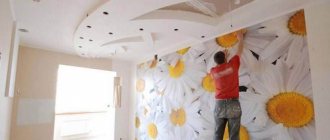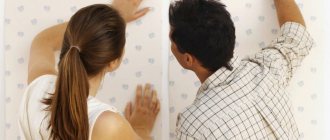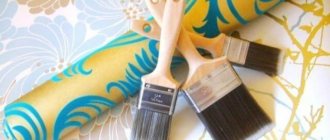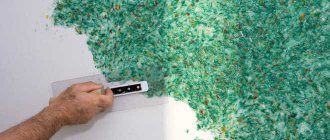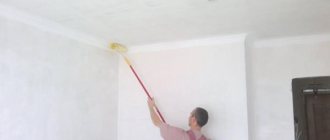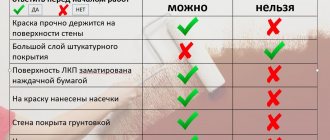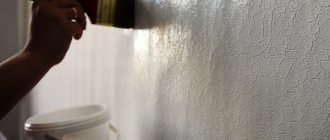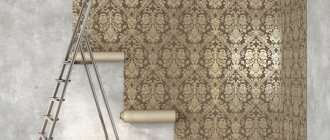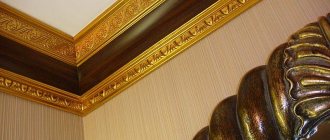March 23, 2016 Floor and wall materials
When renovating their home, homeowners most often prefer to use wallpaper to decorate the walls. This coating has a lot of advantages: wallpaper allows you to create warmth and comfort in your home, reduces the sound permeability of walls, and is easy and quick to apply. Today, the range of wallpaper allows you to choose absolutely any pattern and material composition. When repairs are being made, there is a great desire to complete all the work as quickly as possible.
That is, you can try to do without removing the old wall covering, as required by all regulations. Is it possible to do this, and in what cases? For example, if the walls are covered with old wallpaper or painted with water-based paint. Let's look at this question in more detail.
Pasting new wallpaper over old ones
In some cases, it is indeed possible to stick new wallpaper on the old layer, but for this it is advisable to adhere to several recommendations:
- Old wallpaper must be paper. Vinyl and other synthetic materials will not work. The vinyl surface has a relief, so the new material will not adhere well to it, and the pattern will certainly show through.
- The surface to be left must be smooth. If there are any voluminous monograms, drawings or imprints on it, they must be removed.
- Old canvases must be attached to the walls very firmly. There should be no swelling, peeling, or bubbles.
- It is desirable that the old coating be as thin as possible.
- It is allowed to leave some of the wallpaper if it cannot be removed from the wall.
Assessment of coating quality
If the coating is free of defects in the form of cracks and bubbles, after priming and a little sanding, you can safely glue light wallpaper. However, such situations are extremely rare; the draft version always has small errors. How to cope:
Defects should not be ignored. A few months after cosmetic repairs, they will certainly appear and ruin the appearance of the walls.
Sometimes a small amount of dispersion adhesive may remain on the paint. Residues can be removed using warm water or acetone. This situation may arise if old paintings or light shelves hung on the walls. Without tools, many install decor using the power of glue.
What are the consequences of leaving old wallpaper on the wall?
If you decide to leave the old coating on the walls, you should know the possible consequences of such actions:
- As the glue dries, bubbles may appear on the new canvases, as the existing coating will shrink.
- Old wallpaper can become a source of mold growth or microorganisms that can settle under it.
- Statistics show that new wallpaper, when pasted over old ones, has a shorter service life.
- The old coating may fade when liquid adhesive is applied to it, so color artifacts may appear on the front of the new material.
Tip: if you have pasted very bright wallpaper, it may show through the new layer. To prevent this misunderstanding, darker and denser wallpapers are chosen, preferably also in a saturated color.
Video: How to easily remove old wallpaper
Proper installation of new wallpaper
Before starting wallpaper work, it is necessary to eliminate the possibility of drafts and also turn off the air conditioner. This is necessary for proper drying of the wallpaper. Opening windows and creating air movements is allowed only after the new wallpaper has completely dried.
Sequence of work:
- The section of the wall from ceiling to floor is slightly moistened with water. In this case, sections of old wallpaper that are weakly held on the walls are separated.
- The wall is coated with wallpaper glue.
- The same glue is applied to the canvas cut to the required size.
- The first canvas is being applied.
- Allow some time to assess the quality of the gluing. If after 10-20 minutes no bubbles or stains appear on the new canvas, and the pattern of the old wallpaper is not visible, then you can glue the wallpaper.
- If small bubbles appear, this is considered acceptable. After some time they should disappear.
- The wallpaper is left to dry.
We can conclude that it is advisable to hang wallpaper without removing the old coating. You can glue wallpaper over old strips if you comply with the listed conditions. However, in order to avoid unforeseen accidents, it is advisable to remove old wallpaper. To do this, they need to be moistened with water from a spray bottle, then left for several minutes, and then separated from the wall with a spatula.
Wallpapering with water-based paint
Questions often arise about gluing wallpaper to walls covered with a layer of water-based paint. Such coatings were very popular in previous years, since water-soluble paint is low cost, easy to apply, and lasts for decades. But these days such coating is practically not used; almost everyone prefers wallpaper. Is it possible to glue them to a wall with water-based paint?
Video: Is it possible to hang photo wallpaper on a wall painted with water-based paint?
In most cases, this problem can be resolved positively. Indeed, you can glue wallpaper, but subject to certain conditions:
- The paint should stick to the wall very firmly.
- If there are peelings in some places, they must be removed and the wall surface must be cleaned.
- The surface covered with paint must be free of dust and grease.
Good to know
A few secrets from the masters will help you cope with difficulties at work:
- You can straighten the slanted sheets using a clean cloth. While the glue is wet, the paper must be carefully moved in the desired direction.
- If your eye is not good enough, you can use a pencil and a ruler to mark the location of the canvas.
- When working with non-woven wallpaper, you will have to cover the canvas and walls with glue.
- The resulting bubbles can be removed with a roller or spatula with a rubber tip.
- When carrying out repair work in the cold season, it is necessary to turn off the heating, as it dries out the air and glue.
- Drafts cause damage. It is best to work indoors.
- To reduce the visibility of the seam, the room is pasted in the direction away from the window.
- Sockets and switches are removed before pasting, but the location is marked. In the future, you can remove the excess with a stationery knife and carefully insert them back.
- The ideal air temperature for drying the glue is +18 °C.
- If there is an arch in the room, then you need to allow a supply of wallpaper equal to the width of the arch in order to paste the excess onto this area.
For a high-quality result, it is important to remove all paint on the walls. If the previously applied water-based paint still holds well, which must be verified before the gluing process, you can immediately proceed to renewing the walls.
Determining what paint the walls are covered with
It is very simple to determine that in front of you there really is a surface coated with a water-based emulsion. Each type of paint has its own distinctive features:
- The enamel coating is very difficult to remove. It does not interact with water. Most enamel paints are glossy. It does not bond well with wallpaper due to its low adhesive properties.
- Oil paint can be easily removed from walls, especially from plastered surfaces and concrete. As a rule, it is removed in whole strips. It's not suitable for wallpapering at all.
- Acrylic paint on walls adheres very firmly, forming a durable waterproof coating. Wallpaper can be placed on top of it.
- Water-based paint is easily washed off with water or cleaned off with a spatula. After appropriate preparation, wallpaper can also be pasted onto it.
How to remove water-based paint from walls?
If the paint on the walls does not adhere well or you decide not to risk the quality of the repair, but to remove it completely, then this can be done using the following methods:
- Wash off the paint with warm water. To do this, use a rough washcloth or mitten. Wet it frequently in warm water, wash away the paint, and then remove it with a wet rag. Nothing bad will happen if after such removal white stains remain on the walls. They will not affect the quality of wallpapering at all.
- The paint is cleaned off with a metal spatula. If it is applied to a concrete surface, it will peel off very quickly. The situation is worse with plaster. Care must be taken to ensure that no depressions or irregularities appear on the wall.
Video: An easy way to remove old water-based paint
Necessary equipment
This type of repair implies the presence of:
- tassels,
- roller (for applying glue, removing bubbles),
- stationery knife,
- scissors,
- pencil.
Some types of wallpaper must be cut with an allowance for alignment. If the drawing needs to be adjusted, then the necessary pieces must be cut off as work progresses. It should be trimmed along the bottom; it is better to remove excess with a stationery knife. The glue can be applied with a roller or brush.
Preparing walls and gluing wallpaper
Before wallpapering, the walls must be subjected to the following treatment:
- Walls should be sanded with sandpaper to remove pieces of loose paint and dirt, as well as to roughen the wall surfaces.
- Use a damp cloth to go over all the walls to remove dust. After this, you need to wait until the walls dry.
- Using putty, all detected cracks, irregularities and potholes on the walls are sealed.
- If necessary, the walls are leveled.
- The walls are being primed. To do this, you can use a ready-made primer composition or cover the surfaces with a layer of wallpaper glue. If the glue is thick, it will take a very long time to dry. In this case, it is diluted in half with PVA glue.
- The applied primer must dry completely.
- This completes the preparation of the walls. Wallpaper is glued to the walls in the standard way.
Some experts advise sticking newspapers or other thin paper to the walls before wallpapering. They are partly right, since a thin layer of paper is better able to bind the water-based paint remaining on the walls. However, this approach requires effort and time, so we will not insist on it.
Advice: if you are confused by the presence of cracks on the walls or you are not confident in the quality of wallpapering with water-based emulsion, use liquid wallpaper, which fits perfectly on any surface. In this case, the condition of the paint coating does not matter.
Next step: primer
Nowadays there are primer compositions for sale - for every taste. It is better to choose those with higher adhesive properties; their value should be indicated on the label. Apply in layers with a 2-3 hour break using a brush or roller. Each layer must dry thoroughly before applying the next one.
The primer contains a solvent, thanks to which it penetrates into the thickness of the paint, and accordingly, the connection is very strong. If somewhere the paint does not adhere well, it must be cleaned. And then carefully putty these places and dry them.
Wallpaper is glued to water-based wallpaper in the same way as to a clean wall . True, professionals recommend first making a mixture of wallpaper glue, ordinary but high-quality, and PVA - one to one. This mixture coats not only the painted surface, but also the paper itself before sticking. The mixture can stick anything to anything, and the new wallpaper will stick perfectly to the wall covered with water-based paint, without causing you any trouble.
In addition, if the walls were previously whitewashed, you can safely use the same recipe. The properties of whitewash are similar to the properties of water-emulsion paint, and therefore, if you buy high-quality materials, fussing with water and rags can be avoided.
